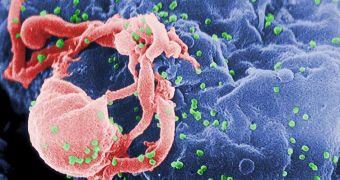In a new series of investigations, researchers have determined that the HIV-like virus which infects monkeys, but which does not really affect its hosts too much, is a lot older than first suspected. It was found that the microorganism first appeared at least 100,000 years ago, although it may have been “aboard” for millions of years. This means that a very long time will pass before the HIV (human immunodeficiency virus) become benign for our species as well, Nature News reports.
Over several millenia, HIV will most likely infect millions of people worldwide, but the condition would be asymptomatic. That is to say, we will carry the virus, but experience no ill effects from it. Many monkeys today carry the simian immunodeficiency virus (SIV), yet very few of them actually develop diseases related to such infections. The new discoveries were presented last week at a meeting of the New York Academy of Sciences. HIV is widely believed to have appeared in humans about 100 years ago, when people in Africa consumed tainted meat that contained the pathogen. More than 33 million people worldwide are currently infected with the virus.
“Don't expect human evolution to unfold in a timeframe that will do anything good for us. We're not going to evolve adaptations that will mitigate this virus in any acceptable timescale, so we need other solutions,” told the meeting expert Michael Worobey, who holds an appointment as an evolutionary biologist at the University of Arizona in Tucson (UAT). The scientist collaborated with colleague Preston Marx, a virologist based at the Tulane University in New Orleans, to discover the age of the virus. The team looked at monkeys on various islands, because they knew when the islands had separated from the mainland. This gave them a tool to analyze the speed at which mutations occurred in the virus, which was essential knowledge for calculating its age.
Originally, the two thought that that SIV had a rate of evolution similar to that of HIV, but the comparative analysis revealed a different story. Apparently SIV, which is widely considered to be the primary ancestor (and source) for the human pathogen, evolves and mutates a lot slower than anybody thought. This implies directly that it's also significantly older than previously calculated. “It's compelling and orthogonal evidence that SIV is a lot older than we previously thought,” believes Rockefeller University cellular immunologist Sarah Schlesinger. She was one of the co-organizers for the New York meeting.

 14 DAY TRIAL //
14 DAY TRIAL //